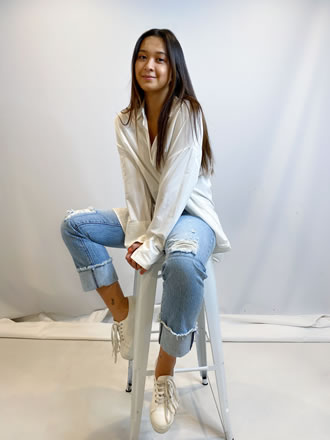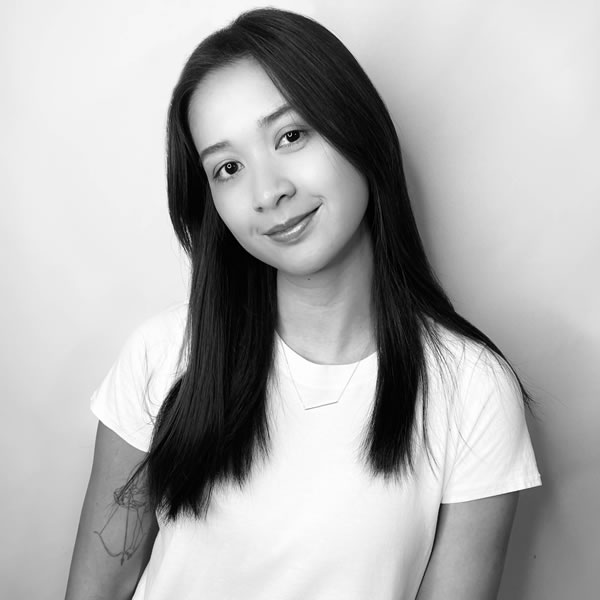Sydney Anh Mai is a product designer at Kickstarter. Born and raised in Hanoi, Vietnam, she spent her adolescence growing up in the United States. Her passion for purposeful interactions and optimized human workflows has taken her across various products, namely IBM, TD Ameritrade, and Emburse. In 2020, she received two Indigo Design Awards and a dotComm award in user experience design. She most recently appeared as a guest-writer on Design Week and Core77.
- Position: Product Designer, Developer
- Industry: Technology
- Location: New York, NY, USA
- Website: SydbyDesign
- LinkedIn: Sydney Anh Mai
- Twitter:
- Instagram:
Sydney Anh, can you start off by telling us about yourself and why you chose the technology profession?
Absolutely! I am what you’d call a “third-culture kid”—a person who spent a significant amount of their upbringing outside their parents’ culture. I spent the first half of my life in Hanoi, Vietnam, and the second half in the States. This cross-cultural exposure has been the main source of my fascination with East vs West application design – something I could probably go on about for hours.
I actually started out at NYU as a Media & Communication major. In my junior year, I took one fateful Intro to Web Design course with Professor Joshua Clayton and the rest was history! I instantly found my medium for creative expression with HTML, CSS, and JavaScript and spent the rest of my college career designing and making websites. I ended minoring in Web Development with a focus on front-end web animations. In fact, my first job after graduation was frontend developer. I gradually made my way to the product world after that job, but I still accredit my whole career to those early years of coding.
Can you tell us what drives you to be successful as a technologist, and product designer?
In many ways, being a technologist has enabled me to find success as a product designer. We need to stop considering these as two separate career paths, but as interconnected disciplines. I’ve always believed that a good designer understands the material of their design – what the thing that they design is made of and how it is made – not just how it looks and feels. A good architect probably knows where the pipes go inside the wall, not just how the room should visually be laid out. Similarly, a good product designer should know enough coding to understand their product’s tech stack and how technical constraints might influence the way they design something. Especially, having a firm understanding of frontend web will also allow them to crank out simple frontend experiments that help validate hypotheses on a larger, more reliable scale.
Tell us about your current role and your vision of improving the user experience.
Currently, I am designing tools for creators at Kickstarter. Our team most recently launched Add-ons, a feature that allows creators to offer and manage optional “add-on” rewards to backers, and backers to add these mini-rewards on top of their pledge. Bringing Add-ons to life was a tremendous effort that took nearly a year of planning, research, design, development, and iteration. Add-ons touches every part of Kickstarter, from our main checkout flow to various transactional emails and secondary product surfaces. I am humbled for the opportunity to lead design on the feature, and super stoked to see how quickly it’s been adopted by creators only a few months after launch.
Kickstarter has been around for more than a decade. We have done amazing things to help creators bring their ideas to life, but most of these happen on the web. While some parts of the creators’ workflow naturally lend themselves to a bigger screen, for example, fulfillment, it doesn’t mean that creators should not be able to accomplish certain tasks such as reward and message management on a smaller screen. I want to challenge this web-first approach when it comes to more complex backend tools and create an easy-access mobile experience for creators, not just backers. Coming from a Saas/enterprise product background, I’ve made it a personal career goal to always push for platform-agnostic and user-friendly backend tools.

What’s the one or two accomplishments that you’re proud of?
In 2019, I led design for a small R&D product called Collabs by SelfMade, which went on to win two Indigo Design Awards and one dotComm for user experience design. Collabs connects small e-commerce shop owners and enables them to run Instagram giveaways, joined email campaigns, and other collaborative marketing efforts. Since I never attended a traditional design program, many of which groom students for award-winning work, this was definitely a newly appreciated feeling for me.
Another moment that I was proud of was seeing my design on The Verge in an article announcing the launch of Add-ons. Add-ons was a project that took many months of design, testing, execution, iteration; it was just nice to see something I designed appear on a major publication.
What advice do you have for other up-and-coming young Women in Technology?
At my first job, I was one of the only two female developers on my team. I’d be lying if I said I never let that deter my path of becoming a full-fledged software engineer. I’d also be lying if I said I was perfectly comfortable voicing my opinions in a meeting room full of men. A lot has changed since as I gained more confidence in my craft, my experience, and my own voice, but if I could go back in time and give my 21-year-old self a little piece of advice, that would be to never let traditional gender role stereotypes deter me from pursuing my careers of interest. Being able to code and build applications doesn’t make me any less feminine, and that being a technologist should not be a career encouraged only for boys. Most importantly, being a woman in tech, there will come times where you’re the only female in the room. You will feel uncomfortable and outnumbered, but let that be a drive to even speak louder, because when you’re a minority, that’s the only way you’ll start getting people’s attention.
Are you active on social media professionally? If so, what platforms work best for engaging your followers
You can find me on LinkedIn!
What is the major difference between being a Developer and Designer?
As someone who has filled the shoes of both, I definitely want these traditionally clearly defined roles to become more fluid. I am talking about designers who can code and coders who are comfortable spinning up a quick UI. However, I am absolutely aware of the different functions that these roles serve and there’re unavoidable different expectations for each. As a developer, I spent a lot of time optimizing the code that I wrote, which was not my favorite thing to do but was an essential part of being a developer. As a designer who codes, I care less about syntax. In this capacity, to me, coding was more of a means to an end – something that helps me prototype and gets my points across.
Who was your biggest influencer?
Beyonce, a true unicorn in the world of performing arts, which has long been a passion of mine. I love watching her rehearsal videos because they show how hard she worked and how much of a perfectionist she is with her craft, which are traits I’ve always valued in any creative profession.
 What is the most challenging part of your work as a Product Designer?
What is the most challenging part of your work as a Product Designer?
Balancing user needs with stakeholders’ expectations. You might think accommodating user needs will be what’s best for the business, and naturally, business needs will always align with user needs. That’s more than often not the case, believe it or not. Business needs are derived from a variety of factors, from revenue goals to human resources. You cannot design in silo and be stubborn about “what’s best for the users.” Your job is not to design the best experience, but the best possible experience with a limited set of tools.
What do you have your sights set on next?
AI am super intrigued by the rise of all-in-one “super apps” like Grab, WeChat, TaoBao, etc. in Asia. You can see Instagram adopting this trend with the introduction of the Shop tab, but by no means to the caliber of the before-mentioned applications. If I could design anything right now, I’d love to design a mini-program that lives within a super app. Imagine Spotify as a super app and the mini-program is an application that allows users to purchase merchandise straight from Spotify. How useful would that be for pop fanatics like me!
What is a day in your life like?
Usually, I like to have a mix of actual pixel-pushing design work and product strategy work. Sometimes, I’ll spend an entire morning on Google Docs briefing a feature and the afternoon on Figma immersing in design. Other times, I’ll spend the morning designing and the afternoon interviewing users or exploring usage patterns on Looker. It’s never the same, but I think having a mix of strategy and actual design work is a good balance.

Do you have any hobbies?
I’ve been dancing since I was 15. Last year was rough for performing arts due to COVID, but I am planning to go back to a dance studio very soon, after getting vaccinated!
What makes you smile?
- Big, bold, beautiful typography
- Success stories of female BIPOC
- Cats
What are you never without?
A portable moisturizer. It would be the best of both worlds for me if there’s a product, sort of like those duo-lipsticks, that disperses sanitizer at one end and moisturizer at the other end.

What scares you?
The “Dribbblization” of product design. These product “glam shots,” while offering quick hits of visual inspiration, also encourages a surface level of understanding of what product designers do. Many prioritize pretty UIs over accessibility, visual trends over system thinking, and fancy animations over helpful interactions. As a product designer, my biggest concern is having the extent of my work reduced to its veneer.
What’s your favorite vacation spot?
Any tropical beach!
List any other work, published articles, interviews or accomplishments:
- “More science than art”: exploring UX design practices,” Design Week.
- “The UX of Invisibility,”Core 77.
- Interview with Susan Weinscheck on her podcast, The Human Tech.
- Interview with The EE Journal’s Fish Fry Podcast
- Interview with Coruzant Technologies Podcast
- “Embracing Cultural Design Differences: Advice for Designers,” Dice Insights.
- “Design With Outcomes: A Case for Objective Design Evaluation,” Dice Insights
- Interview with Authority Mag















